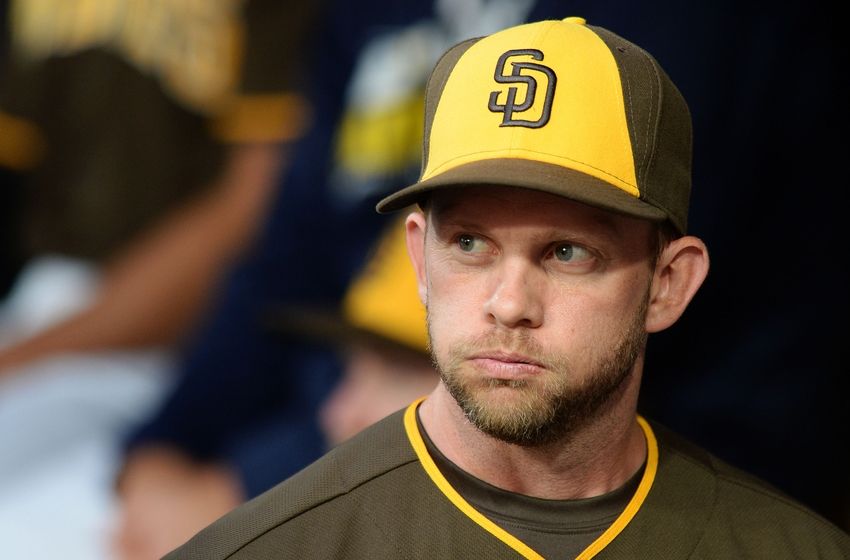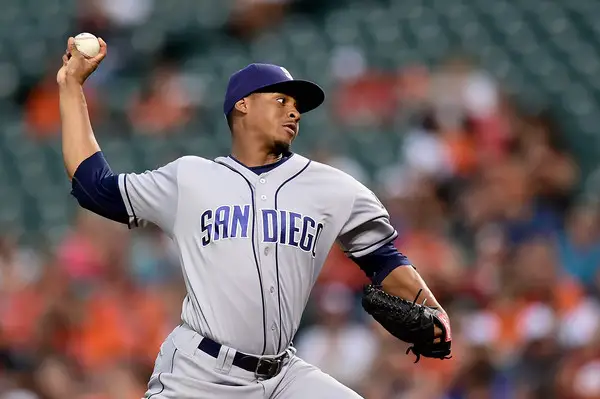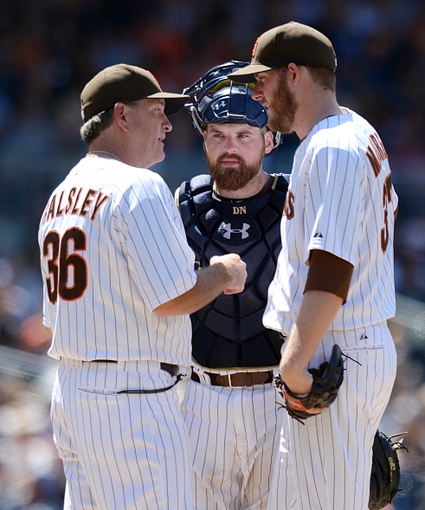Implementing a 3-Man Rotation Would Put Padres WAY Ahead of the Curve

Mandatory Credit: Jake Roth-USA TODAY Sports

I am absolutely enamored with Andrew Miller.
Yes, his talent is undeniable. One could make a case that his disappearing slider, paired with that exploding fastball, coming from a missile launcher attached to a lean and lanky 6’7” frame, could be rendered illegal in some states.
However, beyond his lethal arsenal, I am far more enamored with his workload. When he was traded to the Cleveland Indians prior to the July trading deadline, it was assumed that he would immediately usurp the closer’s role from incumbent Cody Allen. However, Cleveland manager Terry Francona quickly threw this out the window, opting instead to use Allen, Miller, and fellow bullpen weapon Brian Shaw in much more flexible and fluid roles, determining on the fly where they would best fit in the course of a game. This approach manifested itself not only in an A.L. Central title for the Tribe, but the silencing of three of the game’s best offenses – the Red Sox, the Blue Jays, and, at times, the Cubs – while fighting the destiny that seemed to back the North Siders all October.
So why am I talking about the Indians and their peerless ‘pen on a blog that focuses on the often-hapless exploits of the hometown Padres? Because those same Padres have the ability to take the Indians’ management of Miller, Allen, and Co., turn it up a level or four, and jumpstart the future of the professional baseball pitching staff, all while continuing the rebuild the franchise has so desperately needed.
Back in 2009, Dave Fleming wrote an article about the viability of an entirely new kind of pitching rotation. Bill James himself, widely considered the father of the game’s sabermetrics movement, wrote one too, as did longtime baseball writer Rob Neyer. All three write-ups followed a similar theme: do away with the traditional concept of a starting pitcher by implementing a 3-man rotation backed by a deep bullpen.
The formula, borrowed largely from Fleming’s article and a similar one excerpted from Tim Livingston, is fairly simple to carry out. Three starting pitchers rotate through each game of a typical three-game series. These starters (in name only) work through the beginning 3-4 innings of a game, allowed to continue past the first turn of the opponent’s order only based on match-ups and game flow. In a typical game, each would then be followed by 2-3 other pitchers coming out of the bullpen who each throw a couple of innings in relief. The result: no single pitcher throws more than fifty or so pitches in an outing, and each avoids facing a line-up more than once.
For decades, the game has steadily trended away from the iron-man workloads of the past. Gone are the days where Walter Johnson would regularly approach or exceed 350 innings in a season. Gone are the days of Don Drysdale tossing upwards of twenty complete games in a season. In fact, gone too are the days of Greg Maddux tossing even ten complete games in a year (in 2016, Chris Sale led the majors with just six). This has occurred within an environment founded on ongoing discussions about the viability of a six-man rotation, pitch counts and innings limits for up-and-coming aces, and the onslaught of UCL tears that democratically send pitchers from the mound to the disabled list with alarming regularity.
Here’s how all of this ties into the Padres organization and its approach to 2017. While I do expect downward-trending workloads to result in something that resembles a 3-man starting rotation and a 10-12 man staff eventually, I believe that the San Diego Padres specifically are in an outstanding position to get ahead of the curve (think Moneyball for game management) and see if this is an idea that has any real weight behind it. Why is this the case for the habitually down-on-their-luck Friars as they continue pushing for playoff spots that sit many seasons away? Well, I’m glad you asked.
Negatives

First, it would be remiss to advocate for such a strategy without acknowledging some of its potential drawbacks. For one, implementing this Three-Man Rotation (for simplicity, let’s refer it to as the TMR for the duration of this article) is designed to lessen the innings workloads of traditional starting pitchers and distribute them among a team’s collection of bullpen options. This means more innings for pitchers used to smaller workloads, something that could offset the health benefits of the system to the rotation as a whole. However, the majority of relievers are often called upon to throw multiple innings, and I believe that providing them with consistent work would make the strategy a net positive for the pitching staff.
This decrease in innings for current starters and the established flexibility of individual pitching roles for the most part would also mean a lesser likelihood of piling up the large numbers of wins and saves that have traditionally equated to larger dollar signs on contracts and arbitration deals. However, the trade-off between smaller immediate financial returns and the promise of longer careers from improved durability creates a greater potential for the system to be adopted by the players being asked to carry it out.
In both cases, potential negatives that have prevented a system from being implemented before now (although the Colorado Rockies and general manager Dan O’Dowd reportedly tried out a variation of it for a week in 2012) are compensated for by the benefits that accompany those same changes. These benefits come in addition to the following, rendering the strategy at the very least worth a shot in what will almost certainly be an otherwise-lost year for the Padres in 2017.
Increased Durability
In 2016, Padres pitchers combined to throw 1,440 innings. Starters took on almost 62% of this workload, tossing 884 innings. Now, the strain of a mid-90’s heater on the human arm is no secret (for those uneducated few, read this). Neither is the debilitating duress of throwing upwards of 100 pitches in under two hours (this figure obviously does not include warming up before the game or between innings). The TMR would equally divide this workload across an entire staff (1,440 innings split among 12 guys equates to 120 innings per arm, a number that could obviously be adjusted some to account for players’ current stamina levels).
By limiting the volume of a workload in an individual outing, however, the health detriments of being a Major League starting pitcher can be largely avoided. Considering the disabled-list veterans that currently project to hold spots in the Padres’ rotation going forward – Tyson Ross, Colin Rea, Brandon Morrow, Robbie Erlin, Jarred Cosart, etc. – the benefits of planning for limited workloads are clear. The TMR would also allow for consistent workloads for developing youngsters such as Luis Perdomo to expand their repertoire without operating under the high pitch counts typically associated with starting in the big leagues.
PAGE 2 LINK BELOW
Noah is a current undergraduate at the University of San Diego. In addition to his classes as a Business Economics student, Noah serves as the scouting director for the nationally-ranked USD baseball team and as an NFL correspondent with The Mighty 1090. You can follow him on Twitter @thebackseatlamp
What happens when some one has a bad outing and that messes up the “consistent scheduling”? There is absolutely zero chance that you could divide the innings up equally. Also you’re telling me that if you had a completely healthy Tyson Ross, who is easily the padres ace and would be at least a 2 or 3 on other teams, that you would tell him we know you’re good but hey we are only going to let you pitch 3 to 4 innings every two days? 1. That personally that sounds like more stress on an arm 2. You’re limiting your best asset who could literally single handedly win you 20 games (I’m assuming that’s 20 quality starts that the padres below average offense somehow wins). Also you are forgetting that relief pitchers are in the bullpen for a reason. They are meant to throw one inning stints as hard as they can. Look at the decline in Chapman and Miller towards the end of the playoffs and you want to extend that over a 162 game season? Good luck…Also good luck finding 9 copies of some of the best relief pitchers baseball. You’re think outside the box for sure but if this was such a great idea don’t you think someone would have done it already?
Sean, I do see your point, and I think that the limitations the system would put on a team’s best arms is one of the biggest potential drawbacks of the TMR. However, the Padres do not currently have any of those ace-level arms. Even Ross, with his history of success, is a risk considering the surgery he underwent in September for TOS, one that some have termed the new Tommy John because of the long-term question marks it creates. I think an argument could definitely be made for limiting his innings in the interest of staying healthy and prolonging his career. Also, in 2014, when Ross was a Cy Young contender and All-Star, he only won 13 games. I think locking him in for 20 is overly optimistic no matter what line-up is behind him. As for the Chapman-Miller fatigue argument, I believe it is a different situation because those guys were throwing multiple innings almost every day, and neither truly showed signs of fatigue until Game 7 of the World Series (i.e., Game 183 for the Cubbies and Game 180 for the Tribe). That’s not the kind of workload they’d be under in the regular season, where I propose them pitching in around a game per series. As far as the response to “meltdowns” by certain arms, I agree that a bad outing is all but certain on occasion, but that is compensated for by the inclusion of 2-3 additional guys that can be used either more flexibly or designated as the “emergency guy” going into a given game so a pitcher can still plan to pitch that day and the TMR rotation isn’t messed up. Finally, in regards to your final point, that sounds eerily similar to the initial backlash to the Moneyball movement. That is not to say that this is at all on par with the sabermetrics revolution, only to suggest that an idea not being fully implemented yet doesn’t necessarily restrict it from still being a good idea. Overall though, I wholeheartedly appreciate your comments and criticisms. I think a well-rounded approach is necessary to fleshing out any idea as fully as possible. No matter what the Padres do down the road, I think we can both agree that we hope that the Padres make some positive improvements in the near future. This town deserves a good ball club, and hopefully one day it can get one.
Noah (or should I call you Jed Junior?), this might be the best thing I’ve ever read on this site. Please give us more!
Thank you very much for the compliments, Brian! Keep your eye out for more content from Jed Junior in the future!